Kongsberg
Kongsberg (![]()
- Not to be confused with the former Prussian city of Königsberg.
Kongsberg kommune | |
|---|---|
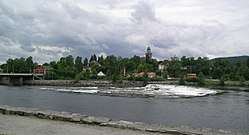 Kongsberg in July 2006 | |
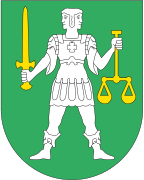 Coat of arms  Viken within Norway | |
| Nickname(s): Teknologibyen The City of Technology | |
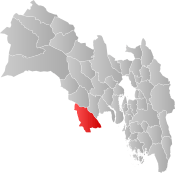 Kongsberg within Viken | |
| Coordinates: 59°34′56″N 9°40′39″E | |
| Country | Norway |
| County | Viken |
| District | Lower Buskerud |
| Administrative centre | Kongsberg |
| Government | |
| • Mayor (2015) | Kari Anne Sand (Sp) |
| Area | |
| • Total | 792 km2 (306 sq mi) |
| • Land | 753 km2 (291 sq mi) |
| Area rank | 138 in Norway |
| Population (2011) | |
| • Total | 25,090 |
| • Rank | 27 in Norway |
| • Density | 31.2/km2 (81/sq mi) |
| • Change (10 years) | 8.9% |
| Demonym(s) | Kongsbering/ Kongsbergenser Kongsbergensar[1] |
| Time zone | UTC+01:00 (CET) |
| • Summer (DST) | UTC+02:00 (CEST) |
| ISO 3166 code | NO-3006 |
| Official language form | Bokmål[2] |
| Website | www |
Kongsberg is the site of the Royal Norwegian Mint (Norwegian: Det Norske Myntverket), which mints Norwegian coins and also produces circulating and collectors' coins for other countries. Kongsberg is also known for being the home of Norway's major defence contractor, Kongsberg Gruppen, formerly Kongsberg Vaapenfabrikk. Two of its well-known products were the Kongsberg Colt and the Krag–Jørgensen rifle.[5]
Name
The name Konningsberg, a modern form Kongsberg, is based on the following two elements: the genitive case of konge which means "king" (referring to King Christian IV) and berg which means "mountain".
Coat-of-arms
The coat-of-arms is from modern times and was designed by Hallvard Trætteberg. They were granted on 25 August 1972. They are based upon the old seal for the city from 1689 which shows the Roman god Janus dressed as an emperor (to represent the king); the sword and the pair of scales represents justice. The colour green represents the forests, silver represents the mountains, and gold represents wealth.[6]
| Ancestry | Number |
|---|---|
| 336 | |
| 282 | |
| 217 | |
| 211 | |
| 175 | |
| 164 | |
| 160 | |
| 136 | |
| 127 | |
| 118 | |
| 117 | |
| 110 |
History
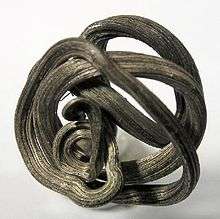
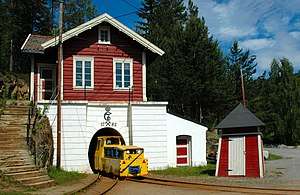


Kongsberg was founded by Danish-Norwegian king Christian IV as a mining community in 1624 after the discovery of silver. In the second year, the town of Kongsberg and the Kongsberg Silver Mines were built. According to official records, the Kongsberg silver mine was discovered by the shepherds Jacob Grosvold and Helge Værp in the summer of 1623. According to the indications of silver mining, the existence of a large amount of precious metals was known before. With the rise of the silver mining industry, it became the largest industrial center in Norway before the industrial revolution. By the peak of the Kongsberg silver mine in the early eighteenth century, Kongsberg's silver mining industry and related industries contributed 10% of the Denmark–Norway gross national product.
In order to develop the Kongsberg Silver Mines, Christian IV hired Germans from the silver mines of Saxony and Harz. In addition, there are also Germans from other mines in Norway. The Germans brought the basic knowledge of mining, which was especially important during the start-up phase of the Kongsberg Silver Mines. Before 1623, the area where the city was located was the royal territory of the original Sandsvær.
Four years after the establishment of the Kongsberg Silver Mines, most of the 1,500 workers and officials were still German. The Norwegians gradually entered the work of Kongsberg and were hired as supervisors. In 1636, 1,370 Germans and 1,600 Norwegians participated in the work. In 1648, 1,500 Germans and 2,400 Norwegians worked in Kongsberg.
Since 1681, gunpowder has been officially introduced for mining. Mining in the particularly hard Kongsberg Mountain is energy intensive, so the silver mine continues to develop technology throughout the operation to reduce production costs. A large artificial dam powers the mine's hoisting system before electricity is introduced. In 1624, a road from Hokksund to Kongsberg was built to serve the Kongsberg Silver Mines, the most important road built in Norway in the 17th century. In 1665, the road was extended to Kristiansand and Larvik.
In 1683, the mining industry became the pillar industry of the state. The rapid development of Kongsberg means that the number of workers in the city has increased significantly by the end of the 17th century. The proportion of Norwegians in the workforce has increased, but for a long time, the position of the main staff is still dominated by the Germans. Kongsberg is almost a small part of Germany in Norway: the mine has a German name, the official language is only in German, and later in German and Danish. In Kongsberg, the German mountain justice system is also used. Legally, this means that the city is bound by independent regulations, such as partially separating the mining community from the country's general laws. The Germans brought a Knappschaft, including free medical assistance, a pension plan, worker sick leave and a Saturday break. The most characteristic ring agriculture in Kongsberg may also be inspired by Germany.
The proceeds from the silver mining industry provided a valuable grant for the tight finances of Denmark. Denmark–Norway relies heavily on the silver of Kongsberg to support the ongoing war against Sweden. Precious metals are also becoming more and more important in the Denmark–Norway currency production. Therefore, in order to get closer to the source of raw materials, the 1686 Royal Mint moved from Akershus to Kongsberg. During the Great Northern War, in 1716, the city became the main target of Karl XII’s stay in Norderhof.
Kongsberg is particularly known for its Kongsberg Silver Mines and its high purity,at the same time, Kongsberg's mine also contains a certain amount of high-purity gold and a large amount of copper, cobalt, lead-zinc and fluorite. From which roughly 15,750 tonnes (34,720,000 lb) [8] of silver was extracted between the discovery of the silver ore seams in 1623 and the last year of mining in 1957.The mining volume of the Kongsberg silver mine began to increase substantially at the end of the 17th century.In the 1769 census, the mines employed about 4,000 workers. With 8,000 inhabitants in total, the town was the second largest in Norway, after Bergen (and thus larger than today's capital, Oslo).[9]
.jpg)
In Norway's 1749 census, Kongsberg was the most populous town in Eastern Norway. It was granted its royal charter of trade—amounting to official township—in 1802. Following several hard years with reduced silver output from the mines, the war of 1807–1814, and a severe town fire in 1810 where 56 houses on the west side were destroyed, mining was complemented by the government establishing a defense industry in 1814. By 1835, the population had declined to 3,540.
Kongsberg is home to the Royal Norwegian Mint (Norwegian: Det Norske Myntverket), which mints Norwegian coins and also produces circulating and collectors' coins for other countries such as Israel. It was established in 1686, and was renamed from the Royal Norwegian Mint (Norwegian: Den Kongelige Mynt) in 2004 after having been sold to private investors (the Mint of Finland and Norwegian company Samlerhuset) in 2003. Kongsberg is also the site of the Kongsberg School of Mines (Kongsberg Bergseminar), an academic institution for mining technology which operated from 1757 to 1814.[10][11]
During peaceful times, the defence industry gradually evolved into many other kinds of high tech activities as well, now dominating the town's employment. In 1987, however, the state-owned Kongsberg Weapons Factory (Kongsberg Vaapenfabrikk) suffered a major financial crisis as well as accusations of breaching the CoCom rules by selling sensitive technology to the Soviet bloc. As a result, the company was split into several smaller units and partly sold to private investors. Today, the separate firms thrive as one of Norway's main high-tech industrial clusters, centering on the defence and maritime company Kongsberg Gruppen which is listed on the Oslo Stock Exchange.[12]
Geography
The neighbouring municipalities of Kongsberg are Flesberg to the north; Øvre Eiker and Hof to the east; Lardal, Siljan, and Skien to the south; and Sauherad and Notodden to the west. Of these, the two first lie in Buskerud county like Kongsberg, while Hof and Lardal lie in Vestfold, and the others lie in Telemark. The town is divided by the river Numedalslågen, which has three waterfalls in the town itself.
Transportation
The main highways are the E134, crossing Kongsberg east to west (and connected to the E18 to Oslo), and Norwegian national road 40 (Riksvei 40), going north to south. The Sørland Line stops at Kongsberg Rail Station, with connection to local and regional bus lines.
Culture

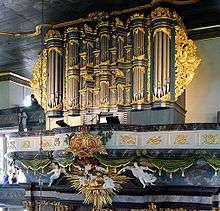
With the population increase during the town's silver mining heyday of the mid-eighteenth century came the need for a new church, which was built over a 21-year period and inaugurated in 1761. It has an austere red brick exterior, but a richly decorated baroque interior including unique chandeliers made at Nøstetangen Glass Works in neighbouring Hokksund. Kongsberg Church remains one of the largest in Norway with a seating capacity of 2,400.
The church's original baroque-era pipe organ, made by renowned German organ builder Gottfried Heinrich Gloger in 1760–65, was fully restored by Jürgen Ahrend in 1999–2000 and reopened to great fanfare in January 2001. With its 42 voices, it is the largest baroque organ in Scandinavia. At the end of January each year, the Gloger Music Festival now draws a select crowd of artists and music lovers from all over the world.
Since 1964, Kongsberg has hosted Kongsberg Jazzfestival, an annual international jazz festival. Heavily sponsored by the local industry, prominent world acts such as BB King, Diana Krall, Ornette Coleman, Joshua Redman and John Scofield have played at the festival in recent years.
Sports
The town is known for many great ski jumpers. Birger Ruud and his two brothers, as well as many other townsmen, such as Petter Hugsted, won numerous medals in Winter Olympics and other international championships in the 1930s and 1940s. The first ski jumping technique, the Konsberger was developed by Jacob Tullin Thams and Sigmund Ruud in Kongsberg, and was the most popular ski jumping technique from the late 1920s to the late 1950s. Their medals and equipment can be seen at the Kongsberg Skiing Museum (Kongsberg Skimuseum) which is co-located with the Norwegian Mining Museum (Norsk Bergverksmuseum) in central Kongsberg. Inventor of the modern ski binding, Norwegian-American skier and Olympic skiing coach Hjalmar Hvam, was born in Kongsberg in 1902. Recent winter sports athletes of the Kongsberg region include Olympic snowboarders Stine Brun Kjeldaas, Silje Norendal and Halvor Lunn; cross-country ski sprinter Børre Næss of the village Efteløt; and ski jumper Sigurd Pettersen of nearby municipality Rollag (60 km/37 mi north of Kongsberg). A large ski centre for alpine skiing and snowboarding, with several lifts and ca 320 m of height difference has been in operation and gradually expanding since 1965. Kongsberg hosted the cross-country skiing parts of the 2006 Nordic skiing National Championships. The arranging sports club was IL Skrim, the ski tracks being located at Heistadmoen, a former military camp.
The local basketball team Kongsberg Miners is regarded one of the best teams in the country.
The 1978 World Orienteering Championships were held in Kongsberg.[13]
The crowns in Håvet
This attraction (Kronene i Håvet) is a site where Norwegian royal monograms have been carved into the mountainside overlooking Kongsberg to mark royal visits to the city. In June 1704 King Frederik IV visited Kongsberg and started a tradition that is still celebrated. King Frederik also arranged for the monograms of visits from earlier monarchs to be recorded as well.
The first monogram on the hillside property belonged to Christian IV who in 1624 founded Kongsberg at the site of the newly discovered silver deposits. His visit was followed by that of Frederik III (1648) and Christian V (1685). Christian VI and his Queen Sofie Magdalene (1733), Frederik V (1749), Oscar I (1845), Oscar II (1890), Haakon VII (1908), Olav V (1962) and most recently Harald V (1995).
Notable residents
- Håkon Austbø - pianist
- Abraham Borch - vicar, dean and member of parliament
- Halfdan Cleve (1879–1951) - composer
- Ivar Grydeland - jazz guitarist
- Maurits Hansen (1794-1842) - journalist and novelist
- Morten Harket - lead singer of the synthpop band a-ha
- Hjalmar Hvam (1902–1996) - Nordic skier
- Petter Hugsted (1921–2000) - ski jumper
- Bryan King - British football goalkeeper and scout
- Roy Mikkelsen (1907-1967) was a Norwegian born, American Olympic ski jumper and US Champion in ski jumping[14]
- Tinius Olsen (1845–1932) - Norwegian-American engineer and inventor
- Morten Qvenild - jazz pianist
- Birger Ruud (1911–1998) - ski jumper
- Sigmund Ruud (1907–1994) - ski jumper
- Christian Sinding (1856–1941) - composer and pianist
- Otto Ludvig Sinding (1842–1909) - painter
- Stephan Abel Sinding (1846–1922) - sculptor
- Daniel-André Tande (1994–) - ski jumper
International relations
Twin towns — sister cities
The following cities are twinned with Kongsberg:[15]







Gallery
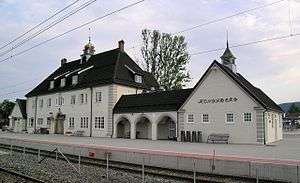 Kongsberg Rail Station
Kongsberg Rail Station- Kongsberg School of Mines
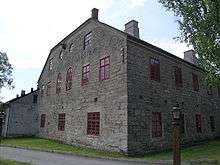 Norwegian Mining Museum
Norwegian Mining Museum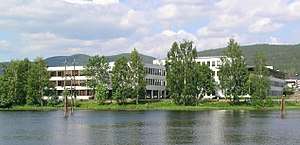 Tinius Olsens School
Tinius Olsens School Kongsberg Bergskrivergaarden
Kongsberg Bergskrivergaarden
See also
References
- Notes
- "Navn på steder og personer: Innbyggjarnamn" (in Norwegian). Språkrådet.
- "Forskrift om målvedtak i kommunar og fylkeskommunar" (in Norwegian). Lovdata.no.
- "Kongsberg". lokalhistoriewiki.no. Retrieved October 1, 2017.
- "Numedal". Store norske leksikon. Retrieved October 1, 2017.
- "Kongsberg Gruppen ASA". Store norske leksikon. Retrieved October 1, 2017.
- "Kommunevåpen" (in Norwegian). Kongsberg kommune. Archived from the original on 2011-07-24. Retrieved 2009-01-10.
- "Immigrants and Norwegian-born to immigrant parents". ssb.no. Archived from the original on 2 July 2015. Retrieved 30 July 2017.
- Kongsberg silver mining district at Mindat.org
- Kongsberg Silver Mining District
- "Det Norske Myntverkets historie". Det Norske Myntverkets. Archived from the original on July 4, 2017. Retrieved October 1, 2017.
- "Kongsberg bergseminar". Store norske leksikon. Retrieved October 1, 2017.
- "Kongsberg Våpenfabrikk". lokalhistoriewiki.no. Retrieved October 1, 2017.
- "World Orienteering Championships 1978". International Orienteering Federation. Retrieved 15 September 2017.
- Roy Mikkelsen (National Ski Hall of Fame)
- "Besøk våre vennskapsbyer!" (in Norwegian). Kongsberg kommune. Archived from the original on 2007-08-09. Retrieved 2009-01-10.
External links
| Wikimedia Commons has media related to Kongsberg. |
| Look up Kongsberg in Wiktionary, the free dictionary. |
| Wikisource has the text of the 1911 Encyclopædia Britannica article Kongsberg. |


- Kongsberg Tourist Office - Comprehensive information about the town and surrounding landscape, including photos and webcams
- Kongsberg Travel Guide- From VirtualTourist.com; contains tourist-submitted photos and articles
- Kongsberg Jazz Festival - Official website, with lists of artists and concert dates (in Norwegian)
- The Gloger Academy - History of the Gloger Organ and information on upcoming concerts and the Gloger Music Festival (in Norwegian)
- Laagendalsposten Local newspaper covering Kongsberg and Numedal (in Norwegian)

